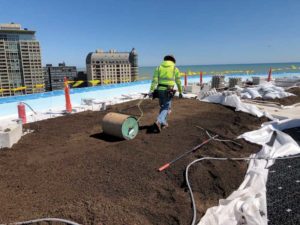Extruded polystyrene in protected membrane roof assemblies
Example 2: Large multifunctional plaza deck PMRA
Another example of a PMRA roof is a large plaza deck which was built in a humid warm climate with mild winters and hot summers (ASHRAE 90.1 Zone 3).
The plaza deck is constructed atop a concrete slab with an area of 13,006 m2 (140,000 sf). The concrete roof deck is covered with a hot-mopped waterproofing membrane. There are 261 drains at the roof deck layer, directly beneath the XPS insulation.

The plaza deck supports the weight of pavers, which serve as ballast and walking surfaces; concrete topping slabs (i.e. split slabs; foot traffic and furnishings; and, in some areas, vegetative roof assemblies [VRAs]). Various XPS types support the differing dead and live load requirements. ASTM C578 Type V XPS is used at locations that require the highest compressive strengths. Type V provides a minimum compressive strength of 690 kPa (100 psi).
Atop the sloped structural deck, the insulation is reverse tapered to provide a flat surface; about 0.3 m (1 ft) of flat insulation follows; and finally, a third course of tapered insulation, sloping to the linear drains at the top of the esthetic surface, completes the insulation thickness. Using insulation to control heights instead of other fills such as concrete reduces the weight across the entire roof.
The layers above the insulation support the various esthetic and functional requirements of the plaza deck. There are layers of filter fabric, a sand bed, pavers, and planters filled with trees. The plaza deck is open to visitors who can enjoy cool evenings outdoors during events at the arena. Meanwhile, when there is a downpour, the deck is engineered to efficiently drain the rainwater from this precisely engineered PMRA.
This project serves as an excellent example of a mixed-use PMRA application that allows for foot traffic and VRAs on a flat occupiable roof with good drainage.
Example 3: PMRA garden roofs and water retention and detention features (blue roof)
The final example is a blue roof design in an urban area where water retention is essential. The 14-storey base building was constructed first, and a 20-storey tower addition is planned for construction five to 10 years into the future. Site conditions required a more creative approach to stormwater management than conventional, below- grade options.
Local regulations required the project account for the total building mass and footprint and a substantial detention requirement of 283 m3 (10,000 cf) of stormwater. Retention volumes are different than detention volumes. Retention occurs within garden roof growing media where the water is retained until used by the plants or evaporated. Detention occurs in a blue roof where water is detained for a specific period until fully released to enter the storm sewers. This prevents flooding the sewer system. The city’s stormwater code required this stormwater volume be released through the flow control drains within 48 hours.
The primary stormwater detention requirement was met by creating two blue roof assemblies on the entire Level 13 and 14 roof structures. These blue roof areas were created using structural voiding units which were subsequently overlaid with garden roofs and paver assemblies for retention capacity and to provide proper ballasting. A conventional garden roof assembly was used on Level 2. The combination of the garden roofs on all levels reduced the overall detention requirement required by the city.
To detain the blue roof water volume, roof drains were modified with a special insert that passively regulates stormwater drainage. The blue roof volume spaces were created using a structural plastic voiding component that is 95 per cent open. To optimize the blue roof storage, the roofs on this building were constructed with flat, zero-slope roof decks. These decks were waterproofed with a hot, fluid-applied, rubberized asphalt membrane and insulated with 178 mm (7 in.) of ASTM C578 Type VI extruded polystyrene insulation. The ability of XPS insulation to resist the wet conditions in a blue roof and green roof make it the perfect choice for thermal insulation.







